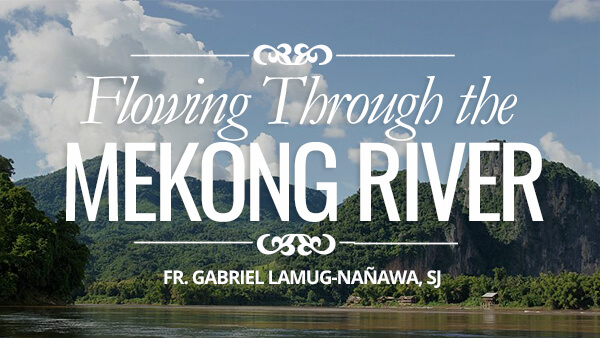


Fr. Gabriel Lamug-Nañawa, SJ
August 24, 2015
We cannot protect something we do not love
we cannot love what we do not know
and we cannot know what we do not see. Or hear. Or sense.
–Richard Louv
As we waded into the water, our feet sank into soft mud, reaching our knees. As in the previous year, we knew that the water current near the middle of the river was something to contend with, as it made the crossing of 850 m seem more like 1 km. Thus, as the whistle blew, all 129 of us started swimming, aiming a good deal upstream of the finish line, in this year’s Mekong River Swim in Cambodia.
Even if crossing the width of this river required a good deal of effort, it said little about the Mekong River’s overall grand scale. This river begins around 5 km above sea level, in the Lasagongma Spring in Mount Guozongmucha in the Tibetan Plateau, and runs for 4,350 km through China, Myanmar, Thailand, Laos, Cambodia, and Vietnam before reaching the South China Sea. Because of its sheer size, it is the longest and largest river by volume in Southeast Asia. It is also the 12th longest river in the world, and the 8th largest by volume in the world.
The Mekong River drains an area of 795,000 km2, bigger than the areas of Belgium, Switzerland, Denmark, Ireland, Austria, Netherlands, Germany, and Bulgaria all put together. It has an annual discharge of 475 km3, which is equivalent to filling up 520,548 Olympic-sized swimming pools each day! And on average, this water flows with a volume of 16,000 cubic meters every second!
Midway across, I began to ask myself what was the point of doing this. The finish line still seemed like miles away and I was already beginning to catch my breath. Without any choice, the coffee-brown water around me would have to be home for a little while longer. At times, more evidently seen during the beginning of the wet season, the color of the Mekong River is like coffee mixed with milk. Many suppose that its color means that it is dirty and contaminated. But high up in China, where the Mekong is called Lancang Jiang, meaning Turbulent River, the Mekong River flows rapidly through steep and narrow gorges, its velocity having carved rock for thousands of years. The swift moving waters pick up a variety of minerals from the underlying structure, gathering a rich mix of sediments with chemical elements that are important for both fish and rice production, especially in the floodplains of Cambodia and Vietnam. In fact, the sediments are so important for the growing of crops that the Mekong Delta, an important depository of sediments from the Mekong River, can produce half the amount of rice needed for the whole of Vietnam.
One of my fears in swimming across this river was getting entangled in a floating fishing net. That was not the right time though to imagine what sort of problems could arise if ever that happened. Surely there were numerous unseen debris flowing beneath the water surface, with many kinds of fish as well. It is not widely known just how essential fish is to the Cambodian diet. In fact, Cambodians consume more freshwater fish than anyone else in the world! On average, each Cambodian takes in 19.43 kg of fish each year, comprising around 80% of their total protein intake. In second place are the Laotians, with 14.35 kg per person per yr, followed by the Thais (7.06 kg/person/yr) and by the Vietnamese (7.04 kg/person/yr). By comparison, the world average is pegged at a distant 2.28 kg/person/yr. That is why in Thailand and Laos, the Mekong River is called Mae Nam Khong, or mother of the waters, because it is on her that so many millions depend for their food and livelihood.
I was nearly out of breath as I reached the west bank of the Mekong River. With only 3 people behind me, I was the 4th to the last person to arrive. Not at all disappointed, I was happy and relieved to make it across, and to experience the mighty Mekong in a different way!
I hope we can all get our feet wet and our hands dirty, that we can find what we love in nature and interact with it in a new and creative way! How about you, what in nature attracts you? What do you find both fascinating and terrifying? Have you gotten to know it a little bit better? May we all grow affective relationships with at least an aspect of God’s creation, that in so doing, we may have the heart and the courage to protect it.
Care of the environment and reconciliation with creation are integral components of the Jesuit mission. Fr. Gabriel Lamug-Nañawa, SJ or Fr. Gabby is currently missioned to Cambodia and coordinates the Ecology Program of Jesuit Service-Cambodia. Be our mission partner by visiting the JesuitAid website.